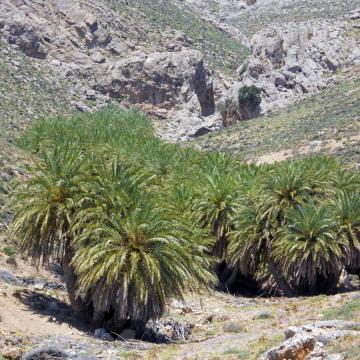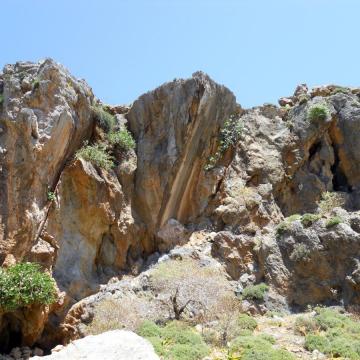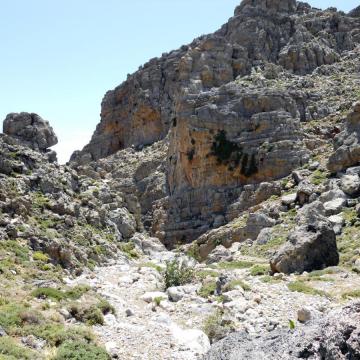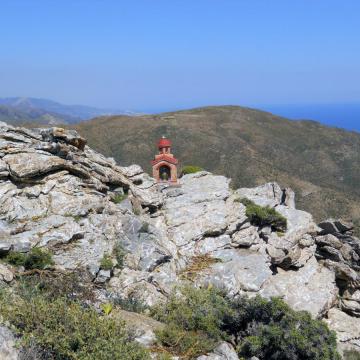GR4310005 - ASTEROUSIA (KOFINAS)
Map
Photos of the site
Quality
The importance of this site consists in: 1) Mount Kofinas provides nesting places for big rapaces, such as Gyps fulvus and, notably of the very rare Gypaetus barbatus. Other interesting birds of prey present in the site are Hieraaetus pennatus and Falco eleonorae; 2) The presence of monk seals in the marine caves; 3) The area hosts endemic and protected plant species. The presence of two Annex II plant species, Phoenix theophrastii and Origanum dictamnus, should be noted. The existence of a well conserved pinewood and of the Cupressus sempervirens patches is also important; 4) There are also interesting endemic snails: Mastus turcidus is endemic to the Aegean and Helicopsis bathytera endemic to the South Aegean; Metefruticicola lecta, Metafruticicola noversa, Trochoidea mesostena, Oxychilus spratti, Deroceras rethimnonensis, Albinaria inflata, Albinaria praeclara, Mastus cretensis and Mastus olivaceus are endemic to Crete; and Albinaria terebra is endemic to Asterousia; 5) The whole site is of archaeological importance, with very interesting caves with prehistoric remnants, archaelogical relics and temples, byzantine monasteries etc.; 6) The aesthetic value of the site due to its morphology; the whole area of Asterousia mountains is a Natural Beauty Landscape.Notes: The fish Sabanejewia aurata balcanica is referred from the area (Corine database), but the reference is false according to the specialist Dr P. S. Economidis (personal communication).OTHER IMPORTANT SPECIES WITH MOTIVATION D:Plants: Erysimum candicum ssp. candicum, Crepis tybakiensis, Campanula saxatilis ssp. saxatilis and Dianthus junniperinus, Lomelosia minoana ssp. asterusica are protected by the Greek Law (Presidential Decree 67/81) and are included in the IUCN Red Data List (1993) in the category of threatened plants characterized as "Rare" in Greece and in the World (1993) and in Europe (1988).Silene vulgaris ssp. suffrutescens is included in the Corine checklist of threatened plants; it is found in only 100 or less sites in EC.Hypericum jovis is protected by the Greek Law (Presidential Decree 67/81) and is included in the IUCN list of threatened species, characterized as "Vulnerable" in Greece and in the World (1993) and in Europe (1988).Crepis pusilla because it is protected by the Greek Law (Presidential Decree 67/81) and is included in the IUCN list of threatened species, characterized as "Rare" in Greece (1993) and in Europe (1988).The orchids Ophrys fusca, Ophrys tenthredinifera and Anacamptis pyramidalis are protected by the CITES Convention (Annex C).Lactuca acanthifolia (= Scariola acanthifolia) is found in Ydra, Cyclades, East Aegean Islands andonly in SW Turkey out of Greece. Filago aegaea ssp. Aristata is a plant with distribution in S & E Aegean, Ionian Islands, Kriti and Cyprus. Malcolmia flexuosa ssp. Naxensis is endemic to the Aegean region and Anatolia.Animals: The snail Helix nucula because has restricted populations in Greece.
Other characteristics
The site includes the eastern range of the massif of Asterousia Ori on southern Crete. The marine area covers less than 1% of the site. The rocks consist mainly of limestones and dolomites, and the lowland eastern area is covered by Neogene sediments. Mount Kofinas, the highest summit (1231 m), is a bare, rugged mountain.On its southern slopes there are woods with Pinus brutia and small patches of Cupressus sempervirens. The dominant vegetation type is phrygana and there are many areas affected by regular overgrazing by sheep and goats. There are also intermittent streams running down to the sea.There are caves in southern Asterousia, most of them very important from the archaeological view.The coastline is rocky and indended with bays and small capes and numerous caves. Notably, there is a small thicket of Phoenix theophrastii at Agios Nikitas cove (near Achendrias).The marine habitats, posidonia beds and reefs are in excellent condition and monk seals live in the marine caves.
Documentation
1) 2, 3.2.c., 3.2.g., 3.3, 4.2., 4.3.
1) CORINE Information System. European Environment Agency. CORINE, Biotopes, 1991.
4.2.
2) Ministry of Environment Physical Planning and Public Works. 1990. (Work Team: A. Legakis et al). Erevnitiko programma. Meleti ton akton tis kritis pou parousiazoun oikologikes diatarahes (Research Programme. Study of the coasts of Kriti that present ecological disturbances). Dept. of Biology. University of Crete, p. 228. 6.2.
3) Ministry of Environment, Physical Planning, and Public Works. 1992. (Work team: Koroni M., Adamoyiannis E., Tzelepoglou R., Papakonstantinoy N., Tseranidis A., Martika M., Veresoglou D., Vakirtzis S., Karamani K., Kaxira C.). Eidiki chorotaxiki meleti kathorismou chriseon gis ton notion akton N. Irakleiou apo orio N. Lasithiou mechri Kokkino Pyrgo me stocho tin prostasia tou perivallontos kai thn touristiki anaptyxi - D fasi, oristiki meleti (Special study for land use in the southern coasts of Irakleion Prefecture from the border of Lassithi Prefecture to Kokkinos Pyrgos, with targets the protection of the environment and tourism development - Phase D, final report. Thessaloniki 83 pp. 4) Economidis P.S. 1991. Checklist of freshwater fishes of Greece. Hell. Soc. Prot. Nat. Spec. publ. 48 p.
5) Georghiou K. 1995. Checklist of endemic, rare and threatened plants of Greece. Draft. University of Athens. (3.3, 3.4, 4.2).
6) Morgan V. and C. Leon. 1992. Datasheets of Flora species for the revision of Appendix I of the Bern Convention. Volum IV. Endemic taxa of Cyprus, Greece and Turkey. Nature and the Environment. No 63, Council of Europe, Publishing and Documentation Service, Strasbourg 106 p. (3.2.g).
7) Natural History Museum of Crete, Conservation of Gypaetus barbatus in Greece.
8) PIEPER H. 1977. Fledermaeuse aus Schleiereulen-Gewoellen von der Insel Kreta. Z. Saeugetierkunde, 42 (1): 7-12.
Reference: Natura 2000 data form, database release 7 Feb 2014







